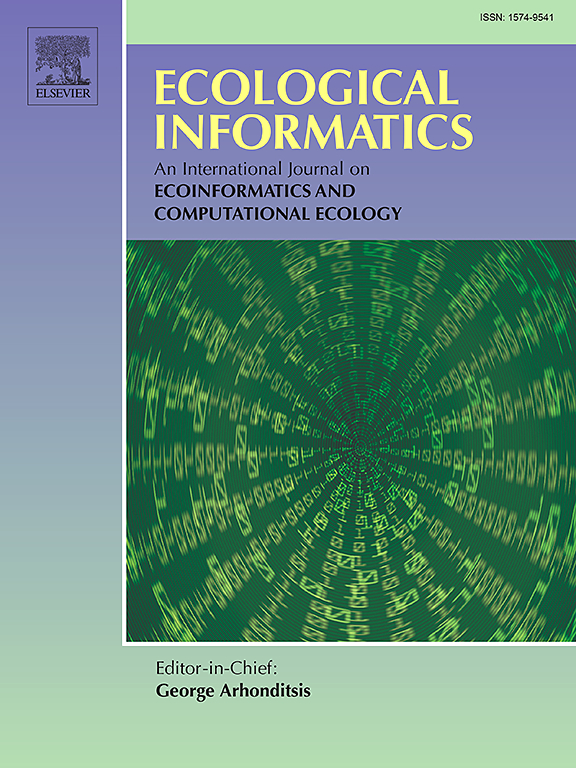How spatial resolution mediates canopy spectral diversity as a proxy for marsh plant diversity
IF 7.3
2区 环境科学与生态学
Q1 ECOLOGY
引用次数: 0
Abstract
Spectral reflectance variations comprehensively capture differences in the biochemical composition and morphological characteristics among plant species, making them a promising approach for monitoring and estimating plant diversity. However, the relationship between spectral reflectance and plant diversity is influenced by multiple factors and remains inherently unstable. Spatial resolution is one of the key factors driving the spatial heterogeneity of spectral information. Currently, it remains unclear how spatial resolution influences the spectral-plant diversity relationship in marshes and what the optimal resolution is for establishing significant correlations. This study focuses on typical marshes in Northeast China, using multispectral data acquired from unmanned aerial vehicle (UAV) at spatial resolutions ranging from 5 cm to 40 cm. Downsampling and upsampling algorithms were applied to resample the spectral data at 5 cm and 40 cm resolutions, generating datasets that cover the entire range from 5 cm to 40 cm. Spectral diversity (SD) indices, including the mean and standard deviation of KNDVI, MTCI, NDREI, and NDVI, were evaluated for their ability to predict plant species diversity across varying spatial resolutions and data sources. Results show that the predictive ability of vegetation indices (VIs) significantly declines as spatial resolution decreases to 40 cm. The optimal spatial resolution for predicting plant diversity varies among different VIs, but VIs calculated from the same spectral bands consistently show similar predictive trends. Notably, MTCI at a 10 cm resolution achieved the highest predictive accuracy for species richness (R2adj = 0.48), the Shannon-Wiener index (R2adj = 0.46), and the Gini-Simpson index (R2adj = 0.43). Furthermore, resampling methods were found to produce lower accuracy in estimating species diversity compared to UAV data acquired on-site. These findings emphasize the importance of selecting appropriate spatial resolutions and SD metrics to enhance the accuracy of remote sensing-based biodiversity prediction models.
空间分辨率如何中介冠层光谱多样性作为沼泽植物多样性的代理
光谱反射率的变化综合反映了植物物种间生化组成和形态特征的差异,是一种很有前景的监测和估计植物多样性的方法。然而,光谱反射率与植物多样性之间的关系受多种因素的影响,具有内在的不稳定性。空间分辨率是影响光谱信息空间异质性的关键因素之一。目前,空间分辨率如何影响湿地光谱-植物多样性关系以及建立显著相关性的最佳分辨率仍不清楚。以东北典型湿地为研究对象,利用无人机(UAV)在5 ~ 40 cm空间分辨率下获取的多光谱数据。采用下采样和上采样算法对5 cm和40 cm分辨率的光谱数据进行重采样,生成覆盖5 cm至40 cm整个范围的数据集。利用光谱多样性(SD)指数,包括KNDVI、MTCI、NDREI和NDVI的均值和标准差,对不同空间分辨率和数据源下植物物种多样性的预测能力进行了评价。结果表明,当空间分辨率降低到40 cm时,植被指数的预测能力显著下降。预测植物多样性的最佳空间分辨率在不同的VIs中存在差异,但在相同光谱波段计算的VIs具有相似的预测趋势。值得注意的是,10 cm分辨率下的MTCI对物种丰富度(R2adj = 0.48)、Shannon-Wiener指数(R2adj = 0.46)和Gini-Simpson指数(R2adj = 0.43)的预测精度最高。此外,与现场获取的无人机数据相比,重采样方法在估计物种多样性方面的准确性较低。这些发现强调了选择合适的空间分辨率和SD指标对于提高基于遥感的生物多样性预测模型的准确性的重要性。
本文章由计算机程序翻译,如有差异,请以英文原文为准。
求助全文
约1分钟内获得全文
求助全文
来源期刊

Ecological Informatics
环境科学-生态学
CiteScore
8.30
自引率
11.80%
发文量
346
审稿时长
46 days
期刊介绍:
The journal Ecological Informatics is devoted to the publication of high quality, peer-reviewed articles on all aspects of computational ecology, data science and biogeography. The scope of the journal takes into account the data-intensive nature of ecology, the growing capacity of information technology to access, harness and leverage complex data as well as the critical need for informing sustainable management in view of global environmental and climate change.
The nature of the journal is interdisciplinary at the crossover between ecology and informatics. It focuses on novel concepts and techniques for image- and genome-based monitoring and interpretation, sensor- and multimedia-based data acquisition, internet-based data archiving and sharing, data assimilation, modelling and prediction of ecological data.
 求助内容:
求助内容: 应助结果提醒方式:
应助结果提醒方式:


